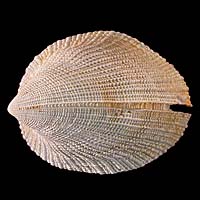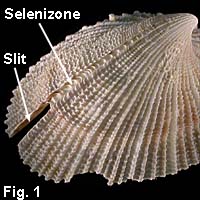|
< Previous family introduction |
|
|||||
 |
Family Fissurellidae Keyhole and slit limpets
|
|||||
|
Shells of the family Fissurellidae are limpet-like in shape, but have an opening for the exhalent water flow and the removal of faeces. Water is drawn in around the head, passes upwards over the gills and leaves via the opening, collecting waste products as it flows out. The opening is of various shapes and in various positions, largely defining the genera. It may be a shallow or deep slit in the anterior margin, or, as in the common large elephant snail, just a weak elevation at the front of the shell. In Diodora it is an opening at the apex, and in Puncturella it is a slit in the anterior slope. In some species with an apical opening there is also a flat plate internally at the apex, dividing the internal space into two partitions. In another variation there is an internal, horizontal flat plate like that of the Calyptraeidae. The shell may completely or only partly cover the animal, or be enveloped in retractable mantle folds. The family is of world wide occurrence, species occurring from the intertidal zone down to at least 1000 metres. They are hard substrate animals; some are herbivores, others feed on sponges, and some consume detritus. Sexes are separate, but there is considerable variation in reproduction and development. Some broadcast eggs and sperm into the sea and larvae are pelagic, while others produce benthic egg masses or brood their young. The NSW representatives of the family are diverse in size, habitat and structure. The most common NSW species, Mortfortula rugosa, is an obvious intertidal animal on rocky shores, living in exposed positions or sheltering in crevices or among other organisms. The black elephant snail, Scutus antipodes, is a spectacular black animal common in intertidal rock pools; the retractable mantle folds may completely enclose the shell. Other smaller species, down to 2 mm in size, live cryptically in the intertidal zone, and are most commonly known from beach shells. There are large and minute species in deep water, down to 1000 metres, only now becoming known from recent deep water sampling. The taxonomy of the family is well defined at the generic level and the large NSW species are well known. However, there is no comprehensive reference to the Australian fauna. The minute species, particularly those from deep water, are in need of study. Family References There is no consolidated reference to the family in Australia. All species known to occur in NSW are illustrated here. Emarginula incisura Adams, 1852 was reported from NSW by Wilson (1993). This is a widespread Indo-West Pacific species. Wilson extended the range to Maroubra, NSW, on the basis that Emarginula bajula Hedley, 1913 is this species. I do not agree with Wilson in this identification, and can find no other records of E. incisura from NSW. Identification Notes: Shells are recognized as belonging to this family by the slit or opening. This is usually obvious, but in some genera, particularly Tugali and Scutus, there is only a weak elevation in the front of the shell. To use the species descriptions it is important to correctly determine the anterior and posterior ends of a specimen. The apex always points backwards, towards the posterior. For those species with a marginal slit, the slit is in the anterior margin. Internally, the horseshoe shaped muscle scar is open at the anterior end. Terminology specific to this family is shown in Fig. 1. The selenizone is a zone from the apex to the slit formed by progressive development of the slit. It may be elevated as a ridge, depressed as a groove, or more or less level with the surrounding shell surface. It may bear transverse ridges called lunulae (singular lunula). It may have raised margins here termed bordering flanges. |
|||||
 |